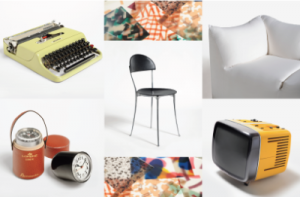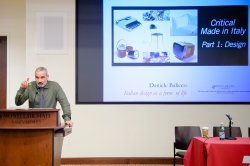
Thursday October 13, 2016 – 6.30-8.30pm
Feliciano School of Business Lecture Hall 101
For directions, select School of Business from campus map
See media coverage for this event
See flyer
This is the first event of the “Critical Made in Italy” series, designed by the Inserra Chair in Italian and Italian American Studies and inspired by a 2016 collection of essays edited by Daniele Balicco – Made in Italy and Culture.
Focused on Italian design, this panel was developed in line with the Week of the Italian Language, which takes place every October worldwide as part of an Italian government’s initiative (its 2016 edition is entitled “Italian and Creativity: Brands and Practices, Fashion and Design”). The goal of the Oct. 13 panel at Montclair State University is to stress the role of contemporary Italy as a major manufacturing power that is at the forefront of innovation – technological and otherwise – in a variety of fields involving design: fashion, furniture, electromechanics, etc. At the same time, the country remains the center of world-renowned artistic and cultural traditions and sites that identify it as the capital of the Dolce Vita. It is in this tension between past, present and future that Italian design offers a unique perspective on objects and environments and the ways in which people interact with them. By blending handmade practices with high-tech processes, and by producing stylish products that incorporate artisanal elements, Italian design has developed, since the pre-WWII period, but especially after the war, a unique aesthetic language that reflects a way of being in the world and a dynamic relationship with history. Provocative and ironic (and even self-ironic), Italian design continues to be a strong point of reference in the design sector, especially for its attention to the broader eco-system of contemporary life. Despite the internationalization of many Italian design companies, the very concept of Italian design still seems to have a distinctive story to tell about beauty, sustainability, and functionality, and this panel will investigate it from different perspectives.
Program
- Introductory remarks: Teresa Fiore (Inserra Chair, MSU) and Sharon Waters (Feliciano School of Business)
- Brief presentation by Iain Kerr (Co-Director MIX Lab / Associate Professor of Innovation Design) to launch the student contest “Inspired by Italy, Designed by You at MIX Lab“
- Speakers:
Daniele Balicco (EHESS École des Hautes Études en sciences sociales 2016-17): “Italian Design as a Form of Life”
Wava Carpenter (Editor in Chief, Pamono): “The Marshall Plan, Milano, MoMA, Memphis: A Brief History of Italian Design”
“Italian Design as a Form of Life” – Daniele Balicco
It is not easy to determine a univocal relationship between design and national identity. Especially today, where the link between territories, cultural training, creation and production of objects is extremely open and globalized. Nevertheless, it cannot be ignored that some countries have been able to create a distinct and recognizable style in the international market. In this regard, the Italian case is very challenging. Its seductive profile can be in part described in connection to its specific cultural history and geography: the nature of the relatively small, but extremely heterogeneous Italian territory lying for centuries at heart of the Mediterranean cultural exchanges; the enigmatically artificial nature of the Italian language and its intimate relation to an international tradition of music; the history of Italian craft traditions and their relationship with the myth of the Renaissance as an archeology of modernity; the relatively late clash of the Italian culture and society with industrial modernity; and the peculiar theoretical training of Italian designers (mostly architects) and their ideological link with anti-establishment movements. Through the intersection of all these “traces”, it may be possible to qualify the multidimensional nature of the Italian style as a “pleasurable” form of modern life.
Daniele Balicco is Visiting Fellow in Theory and Critical Studies at the EHESS (École des Hautes Etudes en Sciences Sociales) of Paris. His theoretical work lies between cultural history, aesthetics and economics. In his first book – Non parlo a tutti. Franco Fortini intellettuale politico/I Don’t Speak to Everyone. Franco Fortini, a Political Intellectual(Roma, 2006) – he analyzed the relationship between political power, the aesthetic dimension, and financial capital. He has continued to focus on this topic as the editor of a special issue of Allegoria(2014) devoted to Edward Said as a political thinker – Lotta politica e riflessione estetica in Edward Said / Edward Said between Politics and Aesthetics. These themes are also central to his more recent work as editor of the volume Made in Italy e cultura. Indagine sull’identità italiana contemporanea (Made in Italy and Culture. Inquiry into the Contemporary Italian Identity, Palumbo 2016). He also works as a freelance journalist for the newspaper Il Manifesto. He lives in Rome.
“The Marshall Plan, Milano, MoMA, Memphis: A Brief History of Italian Design” – Wava Carpenter
This presentation traces a particular history of Italian design from 1945 to today through the lens of a few key exhibitions and promotional efforts, including the Marshall Plan, the Triennale di Milano, the Museum of Modern Art, and more, which have shaped the conversations around Italian production over the last 70 years. The history of Italian design from the postwar era to today exhibits a great variety and breadth—from the artisanal to the industrial, from the decorative to the conceptual. Its identity, however, has been rather consistently described in terms that highlight only a limited set of characteristics: artistic, expressionistic, exuberant, spirited, and the like. From the heyday of modernism to the postmodern rebellion and beyond, its promotional vocabulary—whether academic or popular—remains static. These associations have been viewed as both assets and shortcomings.
A specialist in modern and contemporary design, Wava Carpenter is Director of Content at Pamono, an online magazine and marketplace dedicated to distinctive design objects, past and present, and the stories behind them. Since graduating in 2006 with an MA in Design History from Parsons The New School for Design in New York, she has produced original, design-centered content in a variety of contexts, including cultural and commercial exhibitions, event programs, magazines, and scholarly journals—often in collaboration with luminaries from the global design community.Between 2006 and 2012, she wore many hats at Design Miami—from Director of Culture & Content to Acting Director—where she curated numerous exhibitions and commissioned projects, and was responsible for, among other things, orchestrating the show’s programming, including Design Talks, Design Performances, and Design Awards. Formerly, Wava held a Fellowship at the Cooper-Hewitt, working on exhibitions, such as Second Skin and New Design from Israel, and taught Design Studies at Parsons. Her graduate thesis was titled, “Designing Freedom and Prosperity: The Emergence of Italian Design in Postwar America.”
More information about rules and deadline for the “Student Contest: Italian Design Revisited at MIX Lab, Montclair State University” will be coming soon.
- Spearheaded and sponsored by The Inserra Chair in Italian and Italian American Studies (Department of Spanish and Italian), the program is presented with the cosponsorship of the Feliciano Center for Entrepreneurship and the Global Education Center at Montclair State University, and in collaboration with the Italian Cultural Institute of New York for the Settimana della Lingua Italiana 2016 (Topic: Design e lingua “L’italiano e la creatività: marchi e costumi, moda e design”) and the Mix Lab at Montclair State University.
Resources
Made in Italy
Se Made in Italy fosse un brand sarebbe il terzo al mondo – (Il Sole 24 Ore, article in Italian)
Per un Nuovo Rinascimento Italiano (Il Post, article in Italian by Gabriele Centazzo – see in particular page 2 and 3)
Official speech on Made in Italy and Italian economy
Brief interview with Daniele Balicco (in Italian)
Depressi da politica e crisi? Fate un salto a NY (La Repubblica, Oct. 22, 2016, article in Italian by Federico Rampini)
Andrea Illy: “Su area Expo pronta scuola del saper fare italiano”(Repubblica.it, Nov. 24, 2016, interview with Andrea Illy – in Italian)
Italian Design
ADI (Associazione per il Design Industriale) website
15 Objects that Define Italian Design (CNN article)
“Italy’s Economic Design in Times of Crisis” (2014 New York Times article on Munari exhibit)
Made in Italy Design webpage (contains list of brands)
Select objects related to a program of talks on Italian design (Design Museum, London – see also main selection from collection, including a number of Italian design classics: Vespa, Alessi kettle, and Valentine typewriter)
50 simboli del design italiano, Wired.it (article in Italian)
Italian Design in New York: Gaetano Pesce and Materazzi from Poltrona Frau interviewed by students of Italian at MSU
“How Italian Designers Left Their Imprint on Global Graphic Design.” (New York Times article)
Il Design parla Italiano – Design Speaks Italian (video)
Talk series on Italian Design (MAXXI, Rome, Fall 2016)
For events on similar topics, click here
